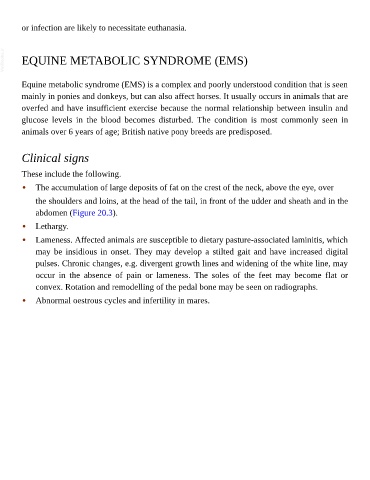Page 970 - The Veterinary Care of the Horse
P. 970
or infection are likely to necessitate euthanasia.
VetBooks.ir EQUINE METABOLIC SYNDROME (EMS)
Equine metabolic syndrome (EMS) is a complex and poorly understood condition that is seen
mainly in ponies and donkeys, but can also affect horses. It usually occurs in animals that are
overfed and have insufficient exercise because the normal relationship between insulin and
glucose levels in the blood becomes disturbed. The condition is most commonly seen in
animals over 6 years of age; British native pony breeds are predisposed.
Clinical signs
These include the following.
• The accumulation of large deposits of fat on the crest of the neck, above the eye, over
the shoulders and loins, at the head of the tail, in front of the udder and sheath and in the
abdomen (Figure 20.3).
• Lethargy.
• Lameness. Affected animals are susceptible to dietary pasture-associated laminitis, which
may be insidious in onset. They may develop a stilted gait and have increased digital
pulses. Chronic changes, e.g. divergent growth lines and widening of the white line, may
occur in the absence of pain or lameness. The soles of the feet may become flat or
convex. Rotation and remodelling of the pedal bone may be seen on radiographs.
• Abnormal oestrous cycles and infertility in mares.

